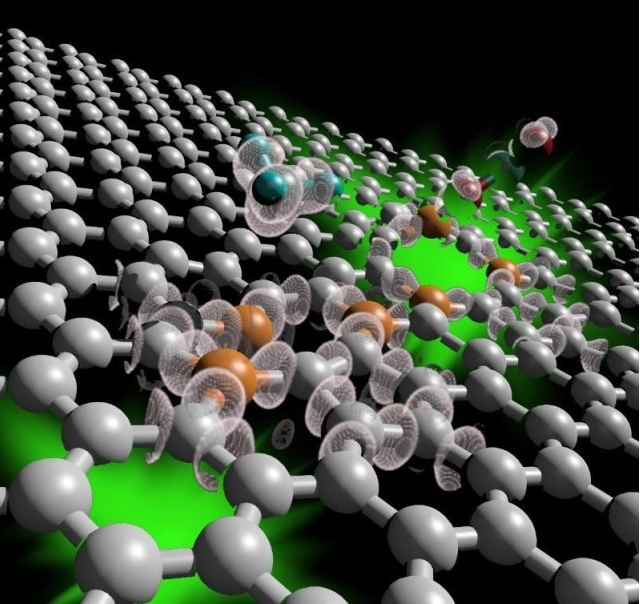A graphene-based gas sensor has been developed. The sensor uses boron-doped graphene to detect toxic gases such as ammonia and nitrogen oxides with up to 10,000 times more sensitivity than current sensors.
 Ultrasensitive gas detection of boron-doped graphene
Ultrasensitive gas detection of boron-doped graphene
The 'wonder material' graphene consists of a 2D matrix of strongly-bound carbon atoms. It has excellent strength and can transport electrons at speeds close to the speed of light. Graphene can also be used as an extremely sensitive gas sensor.
By doping graphene's 2D lattice with boron poisonous gas molecules can be sensed at extremely low concentrations.
So far, two gases; ammonia and nitrogen oxides, have been tested. Ammonia is a major health hazard, whilst nitrogen oxides are hazardous atmospheric pollutants that are the result of vehicle emissions .
The gas molecules in nitrogen oxides can be detected at such low concentrations of parts per billion, and ammonia molecules be sensed in parts per million.
When this is compared to the sensitivity of pure graphene, boron-doped graphene sensors provide 10,000 times more sensitivity towards ammonia, and 27 times more sensitivity towards nitrogen oxides.
The study is a joint collaboration between scientists from six different countries.
According to the research team, the study will pave the way to advanced, high-performance sensors that are capable of sensing trace levels of other gas molecules.
This is a project that we have been pursuing for the past four years. We were previously able to dope graphene with atoms of nitrogen, but boron proved to be much more difficult. Once we were able to synthesize what we believed to be boron graphene, we collaborated with experts in the United States and around the world to confirm our research and test the properties of our material.
Prof. Mauricio Terrones - Penn State University
As nitrogen and boron are adjacent to carbon in the periodic table they share relatively similar atomic radii. This makes it possible to substitute nitrogen and boron. However, boron compounds are highly reactive, meaning they are sensitive to air and quickly disintegrate.
To overcome this issue, a unique chemical vapor deposition system was used to produce sheets that measured 1cm2 in size. This resulted in large graphene sheets, of high quality, which were doped with boron atoms.
The boron graphene samples were compared with already established, ultrasensitive gas sensors. The sensors’ transport mechanism was also examined at Konstantin Novoselov's laboratory of the University of Manchester, UK. Novoselov won the 2010 Nobel Prize for physics for his work on graphene.
Belgium and U.S.-based theory collaborators compared the experimental images and the scanning tunneling microscopy images of the boron-doped sensors. The effect of boron atoms interacting with nitrogen oxide or ammonia molecules was also confirmed. The study also included Japanese and Chinese collaborators.
This multidisciplinary research paves a new avenue for further exploration of ultrasensitive gas sensors. Our approach combines novel nanomaterials with continuous ultraviolet light radiation in the sensor design that have been developed in our laboratory. We believe that further development of this technology may break the parts per quadrillion level of detection limit, which is up to six orders of magnitude better sensitivity than current state-of-the-art sensors.
Avetik Harutyunyan - Honda Research Institute USA
Industries and laboratories that use ammonia gas could benefit from the ultrasensitive sensors. The sensors could be used for detecting flammable or toxic gases, but also to help develop better field-effect transistors and lithium-ion batteries.
The study was supported by the National Natural Science Foundation of China; Honda Research Institute USA; Multidisciplinary University Research awards from the U.S. Air Force Office of Scientific Research; Europe's Graphene Flagship; Penn State's Materials Research Institute, and Penn State's Center for Nanoscale Science, a National Science Foundation MRSEC.
The results of the study have been published in the Proceedings of the National Academy of Sciences.